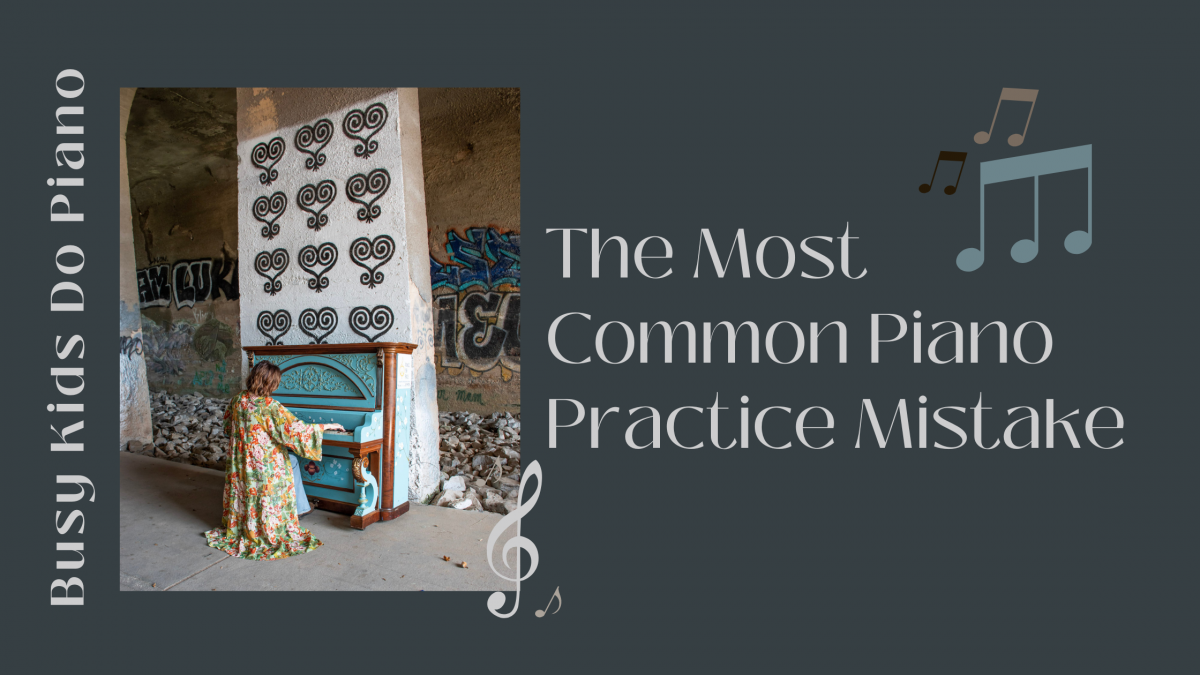Here is a little secret for you that might not surprise you too much: your child’s piano teacher can tell if he practiced.
It usually takes about 15 seconds. Sometimes, it only takes about 4 seconds. I watch a student struggle to find her starting hand position and it becomes clear that she is looking at her music for the very first time since her last lesson.
Here’s the other thing: your child’s teacher can tell if he practiced well.

Sometimes I have a student working on the same piece after 4 or 5 weeks, and I can tell that the piece isn’t actually getting any smoother. The student will say in frustration, “But I practice a half an hour a day!”
There it is, the most common piano practice mistake: requiring a specific length of time at each practice session.
This idea sounds so great, in theory. You’re doing what the teacher asked! You’re requiring daily practice! You’ve built it into your schedule! Your child is practicing for for THIRTY MINUTES!
And while all those things are great, requiring a specific amount of time for each piano practice is actually not an effective way to practice. You may find that your child will look upon these sessions with dread and resentment.
Let me explain some reasons WHY this is a piano practice mistake.
Your child’s practice time will vary from day to day and week to week.
At your child’s first practice after his lesson, he will have new pieces. Those pieces might be really difficult and his first few practices of the week might need to be a bit longer. As he becomes more proficient at these pieces towards the end of the week, he might need only to sit at the piano and run through his homework a few times. If you’re requiring a 30 minute practice session of him, he might not actually need that long to play these pieces. In turn, he could become bored and resentful at having to sit at the piano for so long when he’s already met his goals.
EACH CHILD IS DIFFERENT
Your child might not be able to focus for an extended period of time. If he has to sit too long at the piano, he might begin to unravel towards the end of his session without accomplishing much.
MIXING UP THE GOAL
Requiring a specific length of time focuses on the goal of reaching the end of those minutes. A student might just play pieces over and over until the time is up. Instead, focus on the goal of learning a specific passage or section from a piece. Students then change their focus on correcting mistakes to learn that passage. They are actually having a more efficient piano practice during their session.
You might be wondering how, exactly, to structure a practice if you aren’t requiring a specified time at the piano.
My biggest tip for practicing is this: set a goal, and sit at the piano until the goal is complete.
GOAL-FOCUSED PRACTICE
In case you are wondering what that looks like, are some examples of a goal you might help your child set at the beginning of his practice:
- Learn measures 1-8 hands together
- Learn the first 3 phrases of a piece of music
- Play the 1st page of music at a slow tempo
- Increase the tempo of the 1st page of music
- Learn measures 9-16 with the pedal
Why is it that this is a more effective strategy? Because rather than filling the minutes by just playing a piece beginning to end, your child is forced to break a piece down and work through mistakes.
You know the whole quantity vs. quality thing? We’re aiming for QUALITY of practice over QUANTITY of minutes. Your child may not be able to play the piece of assigned music from the beginning to the end by his next lesson. But chances are that whatever portion of the piece he has learned will be more accurate and polished.
Your child is also permitted to have a more organic, natural flow to practice. You’re setting goals that are specific to what your child needs for that day with that song. He’ll feel successful (not exhausted) at the end of a practice session because he has actually accomplished a measurable goal. Playing for an arbitrary number of minutes that may or may not have been a good match for his age and abilities doesn’t always leave a sense of fulfillment.
SUGGESTED PRACTICE STRUCTURE
Let me tell you how I encourage students to structure their practices:
1-Work through some or all of the written homework (theory)
2-Warm up the fingers – scale, arpeggios, chords, etc.
3-Set a goal for the first piece of music
4-Practice the piece of music until that goal is met. Use tricks such as practicing at a SLOW tempo, practicing hands separately or repeating difficult parts to help reach the goal.
5-Repeat steps 3-4 for the next piece of music, if your child has the stamina. (If not, walk away and come back to it tomorrow!)
6-End with something fun! Play an “old favorite” that your child loves or play a duet together. Try out a rhythm ensemble using the drums. Anything that allows your child to end his practice session on a positive note. (Don’t skip this step! It is so important!)
Re-structuring your child’s practices to be goal-focused rather than time-focused will allow you to see so much more growth and progress in your child. Chances are, he’ll also enjoy practicing more as he begins to feel successful and see results!
Were you guilty of this piano practice mistake? How will you be changing practices to be more effective?





5 thoughts on “The Most Common Piano Practice Mistake.”